B01SYAD310: System Analysis and Design Report for SMC
VerifiedAdded on 2022/11/13
|15
|2467
|167
Report
AI Summary
This report presents a comprehensive system analysis and design for the Sydney Medical Centre (SMC), addressing the need for a new information system to overcome the limitations of its current business processes. The report, prepared by an IT consultant, begins with an executive summary outlining the project's scope and objectives. It details both functional and non-functional requirements for the new hospital information system, including patient data storage, appointment scheduling, reporting, and system availability, reliability, security, usability, and scalability. The report then explores fact-finding methods, such as interviews, to gather data and understand the current system's performance. It also discusses the use of system development tools like CASE tools (e.g., Microsoft Visio) for UML modeling, and database and interface modeling. Finally, it outlines two system development methodologies: Prototyping and Rapid Application Development (RAD), which are suggested to speed up the development process. The report concludes by emphasizing the importance of the new information system in improving the efficiency of SMC's business procedures and its overall standing in the medical field. Appendices include diagrams such as Use Case, Context, Level 0, and ERD for the SMC system.
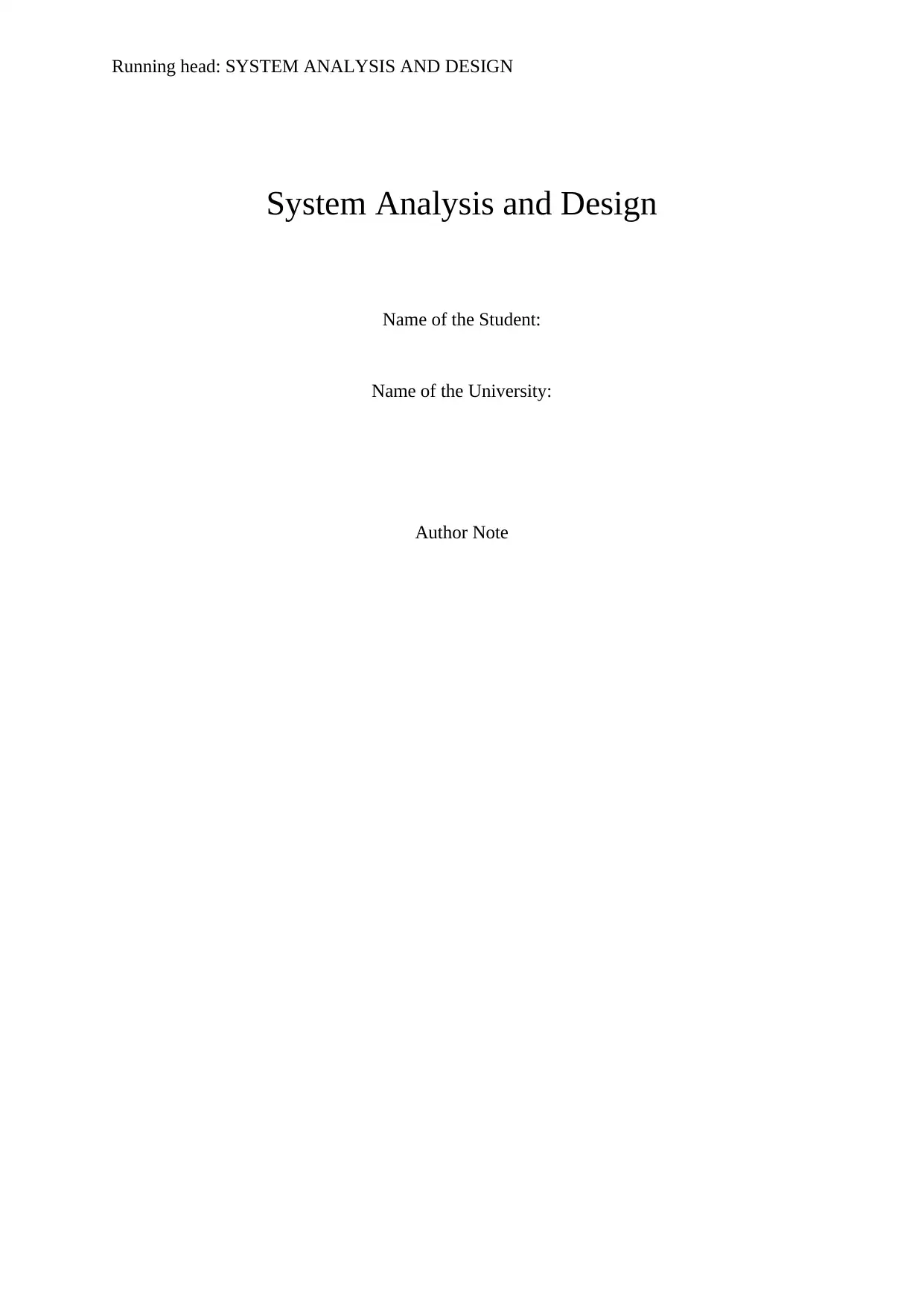
Running head: SYSTEM ANALYSIS AND DESIGN
System Analysis and Design
Name of the Student:
Name of the University:
Author Note
System Analysis and Design
Name of the Student:
Name of the University:
Author Note
Paraphrase This Document
Need a fresh take? Get an instant paraphrase of this document with our AI Paraphraser
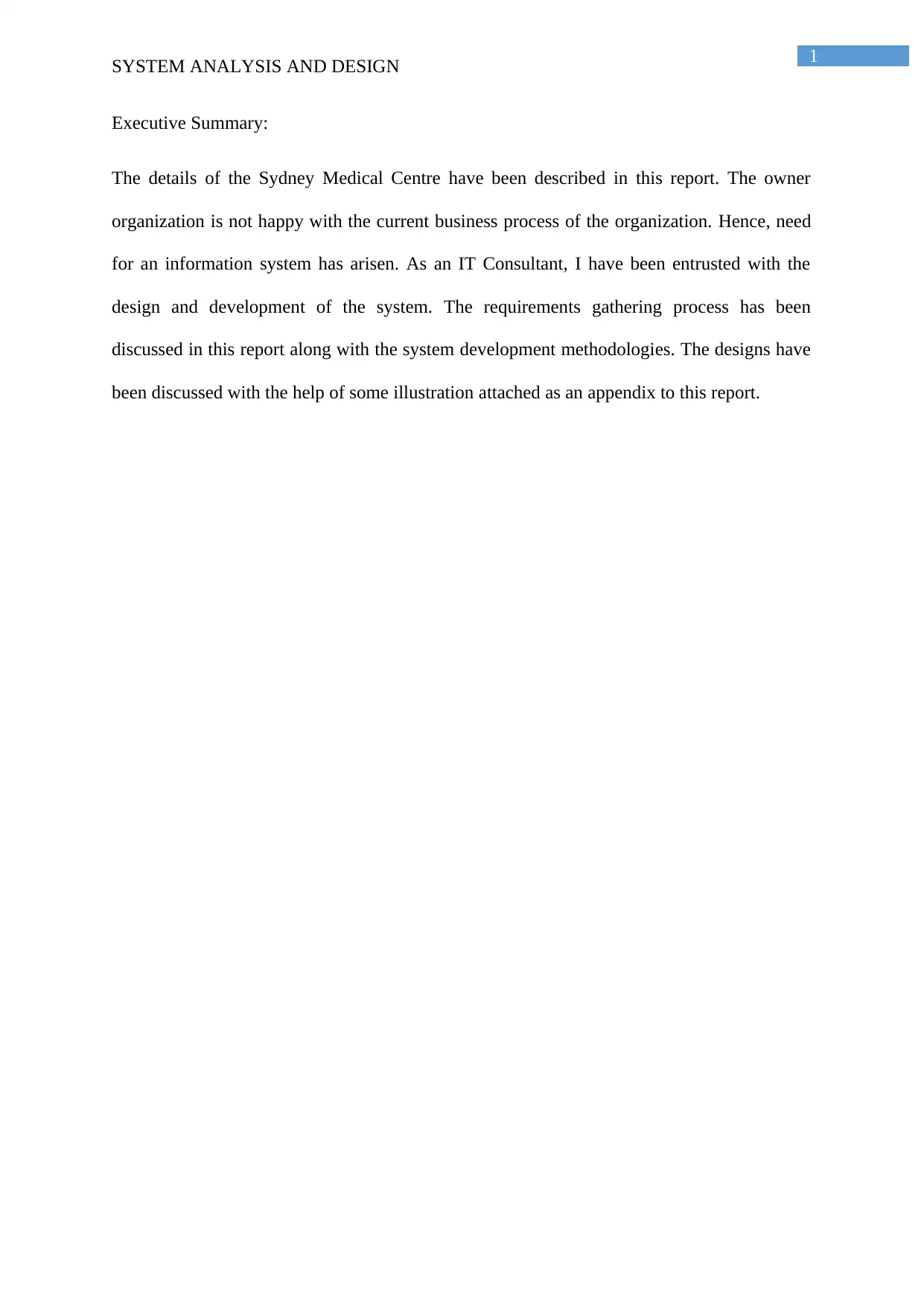
1
SYSTEM ANALYSIS AND DESIGN
Executive Summary:
The details of the Sydney Medical Centre have been described in this report. The owner
organization is not happy with the current business process of the organization. Hence, need
for an information system has arisen. As an IT Consultant, I have been entrusted with the
design and development of the system. The requirements gathering process has been
discussed in this report along with the system development methodologies. The designs have
been discussed with the help of some illustration attached as an appendix to this report.
SYSTEM ANALYSIS AND DESIGN
Executive Summary:
The details of the Sydney Medical Centre have been described in this report. The owner
organization is not happy with the current business process of the organization. Hence, need
for an information system has arisen. As an IT Consultant, I have been entrusted with the
design and development of the system. The requirements gathering process has been
discussed in this report along with the system development methodologies. The designs have
been discussed with the help of some illustration attached as an appendix to this report.
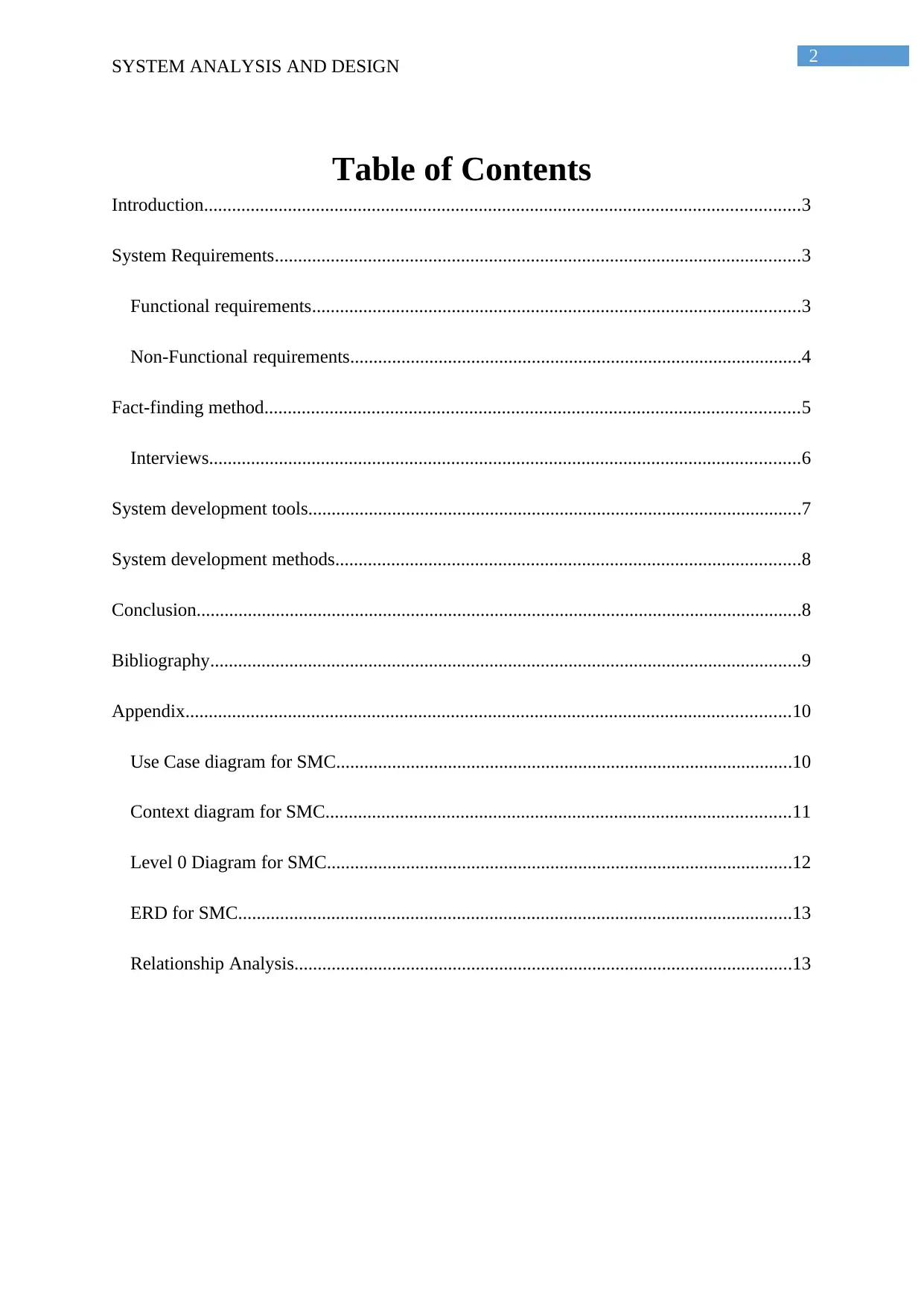
2
SYSTEM ANALYSIS AND DESIGN
Table of Contents
Introduction................................................................................................................................3
System Requirements.................................................................................................................3
Functional requirements.........................................................................................................3
Non-Functional requirements.................................................................................................4
Fact-finding method...................................................................................................................5
Interviews...............................................................................................................................6
System development tools..........................................................................................................7
System development methods....................................................................................................8
Conclusion..................................................................................................................................8
Bibliography...............................................................................................................................9
Appendix..................................................................................................................................10
Use Case diagram for SMC..................................................................................................10
Context diagram for SMC....................................................................................................11
Level 0 Diagram for SMC....................................................................................................12
ERD for SMC.......................................................................................................................13
Relationship Analysis...........................................................................................................13
SYSTEM ANALYSIS AND DESIGN
Table of Contents
Introduction................................................................................................................................3
System Requirements.................................................................................................................3
Functional requirements.........................................................................................................3
Non-Functional requirements.................................................................................................4
Fact-finding method...................................................................................................................5
Interviews...............................................................................................................................6
System development tools..........................................................................................................7
System development methods....................................................................................................8
Conclusion..................................................................................................................................8
Bibliography...............................................................................................................................9
Appendix..................................................................................................................................10
Use Case diagram for SMC..................................................................................................10
Context diagram for SMC....................................................................................................11
Level 0 Diagram for SMC....................................................................................................12
ERD for SMC.......................................................................................................................13
Relationship Analysis...........................................................................................................13
⊘ This is a preview!⊘
Do you want full access?
Subscribe today to unlock all pages.

Trusted by 1+ million students worldwide
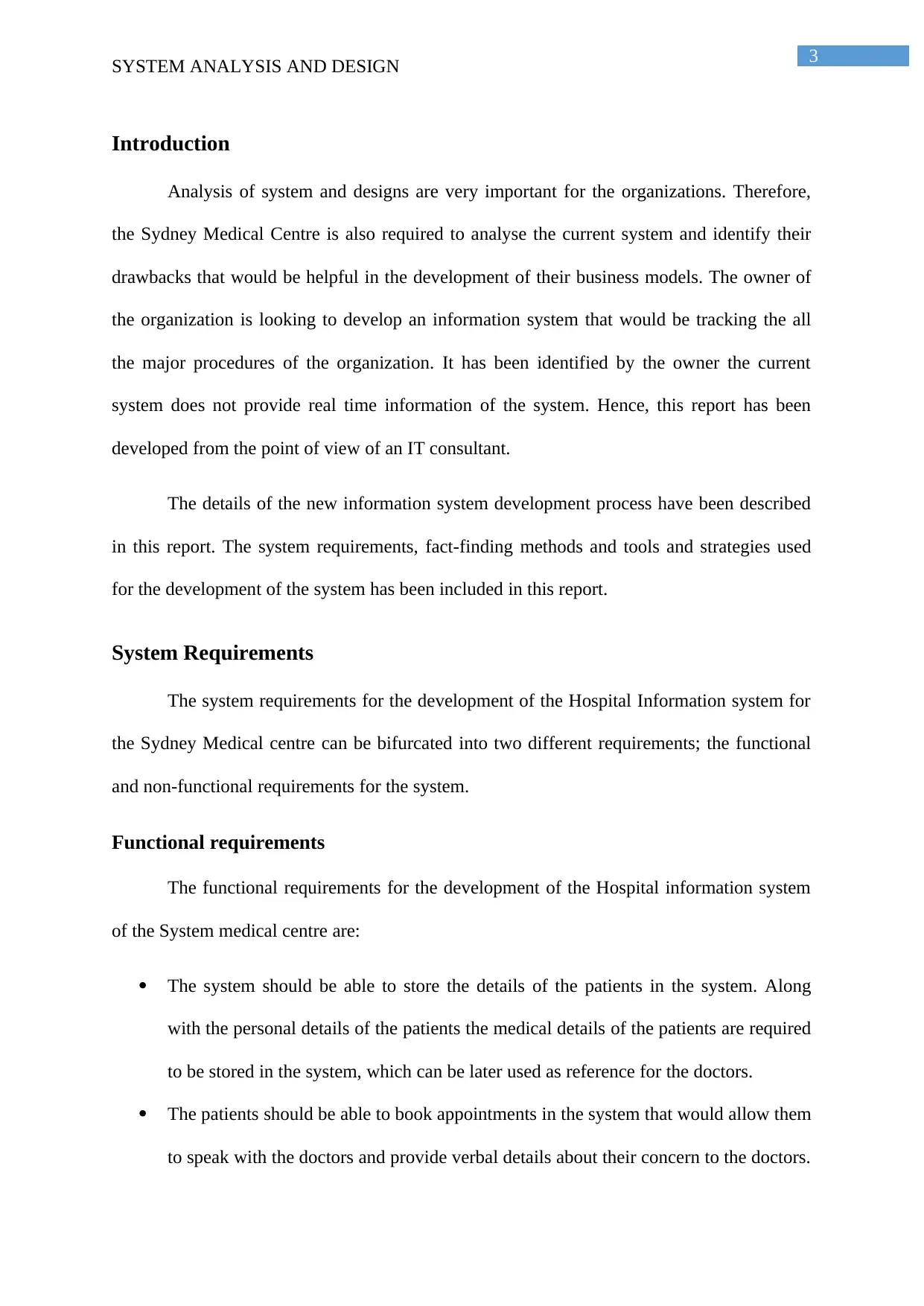
3
SYSTEM ANALYSIS AND DESIGN
Introduction
Analysis of system and designs are very important for the organizations. Therefore,
the Sydney Medical Centre is also required to analyse the current system and identify their
drawbacks that would be helpful in the development of their business models. The owner of
the organization is looking to develop an information system that would be tracking the all
the major procedures of the organization. It has been identified by the owner the current
system does not provide real time information of the system. Hence, this report has been
developed from the point of view of an IT consultant.
The details of the new information system development process have been described
in this report. The system requirements, fact-finding methods and tools and strategies used
for the development of the system has been included in this report.
System Requirements
The system requirements for the development of the Hospital Information system for
the Sydney Medical centre can be bifurcated into two different requirements; the functional
and non-functional requirements for the system.
Functional requirements
The functional requirements for the development of the Hospital information system
of the System medical centre are:
The system should be able to store the details of the patients in the system. Along
with the personal details of the patients the medical details of the patients are required
to be stored in the system, which can be later used as reference for the doctors.
The patients should be able to book appointments in the system that would allow them
to speak with the doctors and provide verbal details about their concern to the doctors.
SYSTEM ANALYSIS AND DESIGN
Introduction
Analysis of system and designs are very important for the organizations. Therefore,
the Sydney Medical Centre is also required to analyse the current system and identify their
drawbacks that would be helpful in the development of their business models. The owner of
the organization is looking to develop an information system that would be tracking the all
the major procedures of the organization. It has been identified by the owner the current
system does not provide real time information of the system. Hence, this report has been
developed from the point of view of an IT consultant.
The details of the new information system development process have been described
in this report. The system requirements, fact-finding methods and tools and strategies used
for the development of the system has been included in this report.
System Requirements
The system requirements for the development of the Hospital Information system for
the Sydney Medical centre can be bifurcated into two different requirements; the functional
and non-functional requirements for the system.
Functional requirements
The functional requirements for the development of the Hospital information system
of the System medical centre are:
The system should be able to store the details of the patients in the system. Along
with the personal details of the patients the medical details of the patients are required
to be stored in the system, which can be later used as reference for the doctors.
The patients should be able to book appointments in the system that would allow them
to speak with the doctors and provide verbal details about their concern to the doctors.
Paraphrase This Document
Need a fresh take? Get an instant paraphrase of this document with our AI Paraphraser
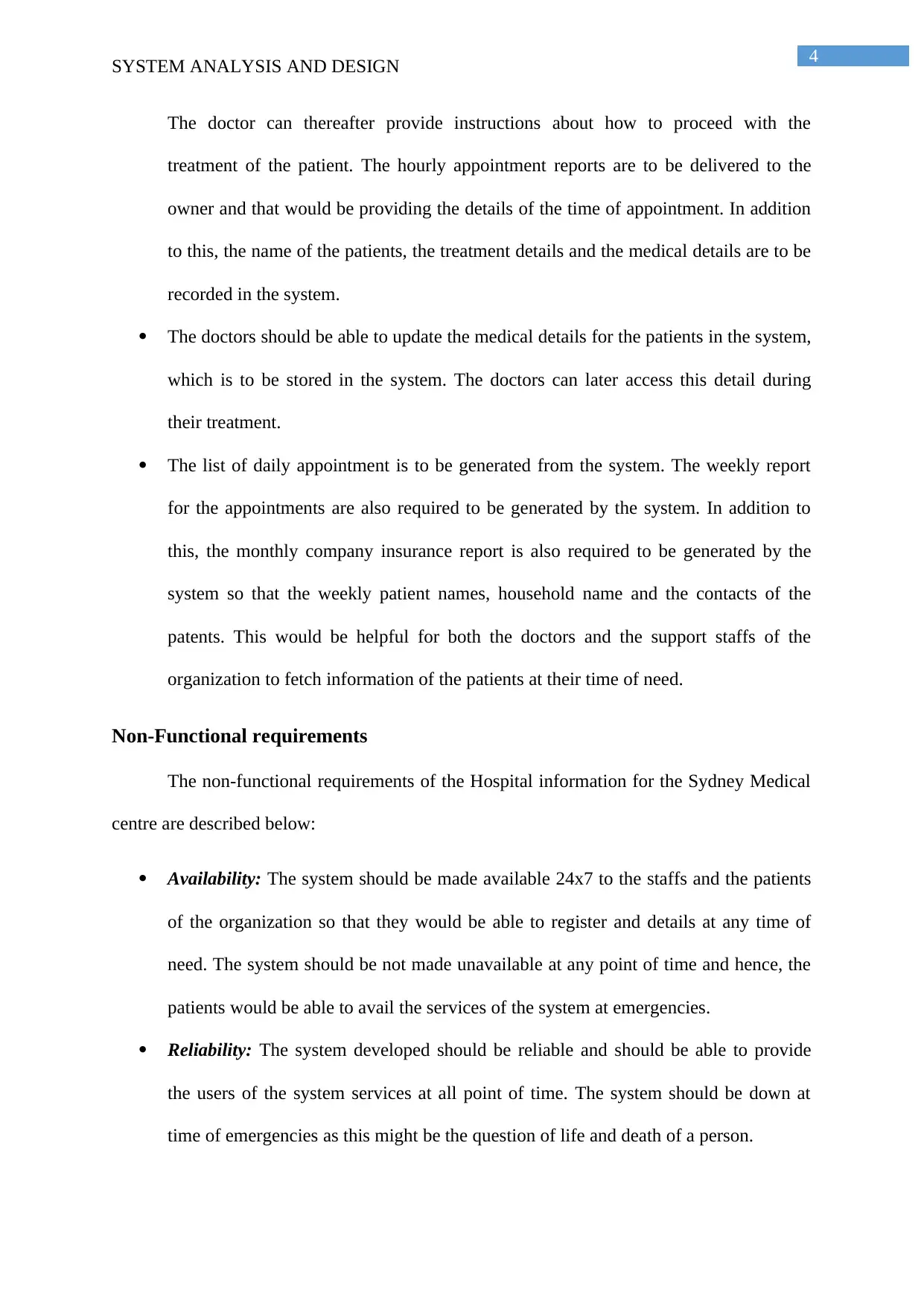
4
SYSTEM ANALYSIS AND DESIGN
The doctor can thereafter provide instructions about how to proceed with the
treatment of the patient. The hourly appointment reports are to be delivered to the
owner and that would be providing the details of the time of appointment. In addition
to this, the name of the patients, the treatment details and the medical details are to be
recorded in the system.
The doctors should be able to update the medical details for the patients in the system,
which is to be stored in the system. The doctors can later access this detail during
their treatment.
The list of daily appointment is to be generated from the system. The weekly report
for the appointments are also required to be generated by the system. In addition to
this, the monthly company insurance report is also required to be generated by the
system so that the weekly patient names, household name and the contacts of the
patents. This would be helpful for both the doctors and the support staffs of the
organization to fetch information of the patients at their time of need.
Non-Functional requirements
The non-functional requirements of the Hospital information for the Sydney Medical
centre are described below:
Availability: The system should be made available 24x7 to the staffs and the patients
of the organization so that they would be able to register and details at any time of
need. The system should be not made unavailable at any point of time and hence, the
patients would be able to avail the services of the system at emergencies.
Reliability: The system developed should be reliable and should be able to provide
the users of the system services at all point of time. The system should be down at
time of emergencies as this might be the question of life and death of a person.
SYSTEM ANALYSIS AND DESIGN
The doctor can thereafter provide instructions about how to proceed with the
treatment of the patient. The hourly appointment reports are to be delivered to the
owner and that would be providing the details of the time of appointment. In addition
to this, the name of the patients, the treatment details and the medical details are to be
recorded in the system.
The doctors should be able to update the medical details for the patients in the system,
which is to be stored in the system. The doctors can later access this detail during
their treatment.
The list of daily appointment is to be generated from the system. The weekly report
for the appointments are also required to be generated by the system. In addition to
this, the monthly company insurance report is also required to be generated by the
system so that the weekly patient names, household name and the contacts of the
patents. This would be helpful for both the doctors and the support staffs of the
organization to fetch information of the patients at their time of need.
Non-Functional requirements
The non-functional requirements of the Hospital information for the Sydney Medical
centre are described below:
Availability: The system should be made available 24x7 to the staffs and the patients
of the organization so that they would be able to register and details at any time of
need. The system should be not made unavailable at any point of time and hence, the
patients would be able to avail the services of the system at emergencies.
Reliability: The system developed should be reliable and should be able to provide
the users of the system services at all point of time. The system should be down at
time of emergencies as this might be the question of life and death of a person.
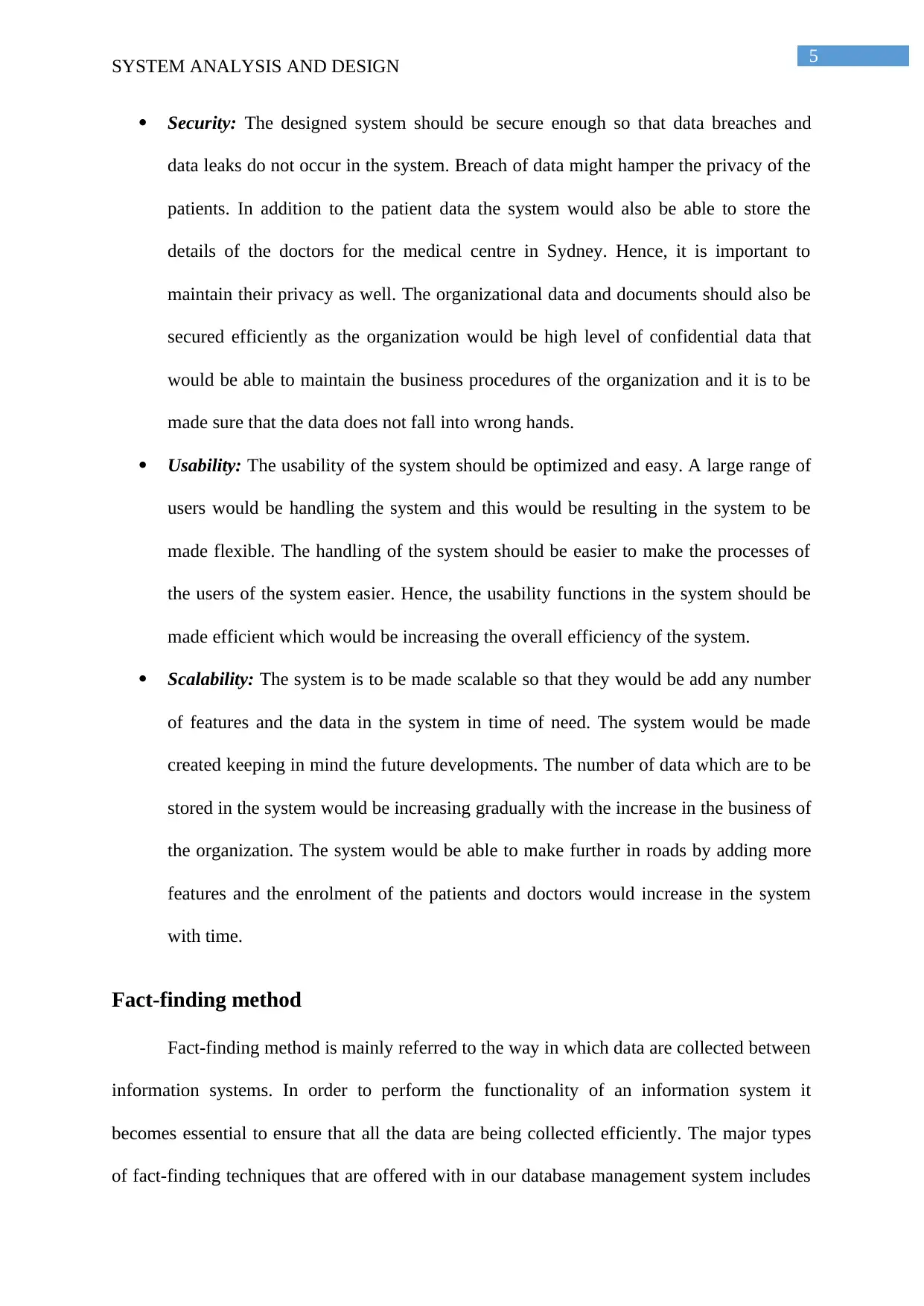
5
SYSTEM ANALYSIS AND DESIGN
Security: The designed system should be secure enough so that data breaches and
data leaks do not occur in the system. Breach of data might hamper the privacy of the
patients. In addition to the patient data the system would also be able to store the
details of the doctors for the medical centre in Sydney. Hence, it is important to
maintain their privacy as well. The organizational data and documents should also be
secured efficiently as the organization would be high level of confidential data that
would be able to maintain the business procedures of the organization and it is to be
made sure that the data does not fall into wrong hands.
Usability: The usability of the system should be optimized and easy. A large range of
users would be handling the system and this would be resulting in the system to be
made flexible. The handling of the system should be easier to make the processes of
the users of the system easier. Hence, the usability functions in the system should be
made efficient which would be increasing the overall efficiency of the system.
Scalability: The system is to be made scalable so that they would be add any number
of features and the data in the system in time of need. The system would be made
created keeping in mind the future developments. The number of data which are to be
stored in the system would be increasing gradually with the increase in the business of
the organization. The system would be able to make further in roads by adding more
features and the enrolment of the patients and doctors would increase in the system
with time.
Fact-finding method
Fact-finding method is mainly referred to the way in which data are collected between
information systems. In order to perform the functionality of an information system it
becomes essential to ensure that all the data are being collected efficiently. The major types
of fact-finding techniques that are offered with in our database management system includes
SYSTEM ANALYSIS AND DESIGN
Security: The designed system should be secure enough so that data breaches and
data leaks do not occur in the system. Breach of data might hamper the privacy of the
patients. In addition to the patient data the system would also be able to store the
details of the doctors for the medical centre in Sydney. Hence, it is important to
maintain their privacy as well. The organizational data and documents should also be
secured efficiently as the organization would be high level of confidential data that
would be able to maintain the business procedures of the organization and it is to be
made sure that the data does not fall into wrong hands.
Usability: The usability of the system should be optimized and easy. A large range of
users would be handling the system and this would be resulting in the system to be
made flexible. The handling of the system should be easier to make the processes of
the users of the system easier. Hence, the usability functions in the system should be
made efficient which would be increasing the overall efficiency of the system.
Scalability: The system is to be made scalable so that they would be add any number
of features and the data in the system in time of need. The system would be made
created keeping in mind the future developments. The number of data which are to be
stored in the system would be increasing gradually with the increase in the business of
the organization. The system would be able to make further in roads by adding more
features and the enrolment of the patients and doctors would increase in the system
with time.
Fact-finding method
Fact-finding method is mainly referred to the way in which data are collected between
information systems. In order to perform the functionality of an information system it
becomes essential to ensure that all the data are being collected efficiently. The major types
of fact-finding techniques that are offered with in our database management system includes
⊘ This is a preview!⊘
Do you want full access?
Subscribe today to unlock all pages.

Trusted by 1+ million students worldwide
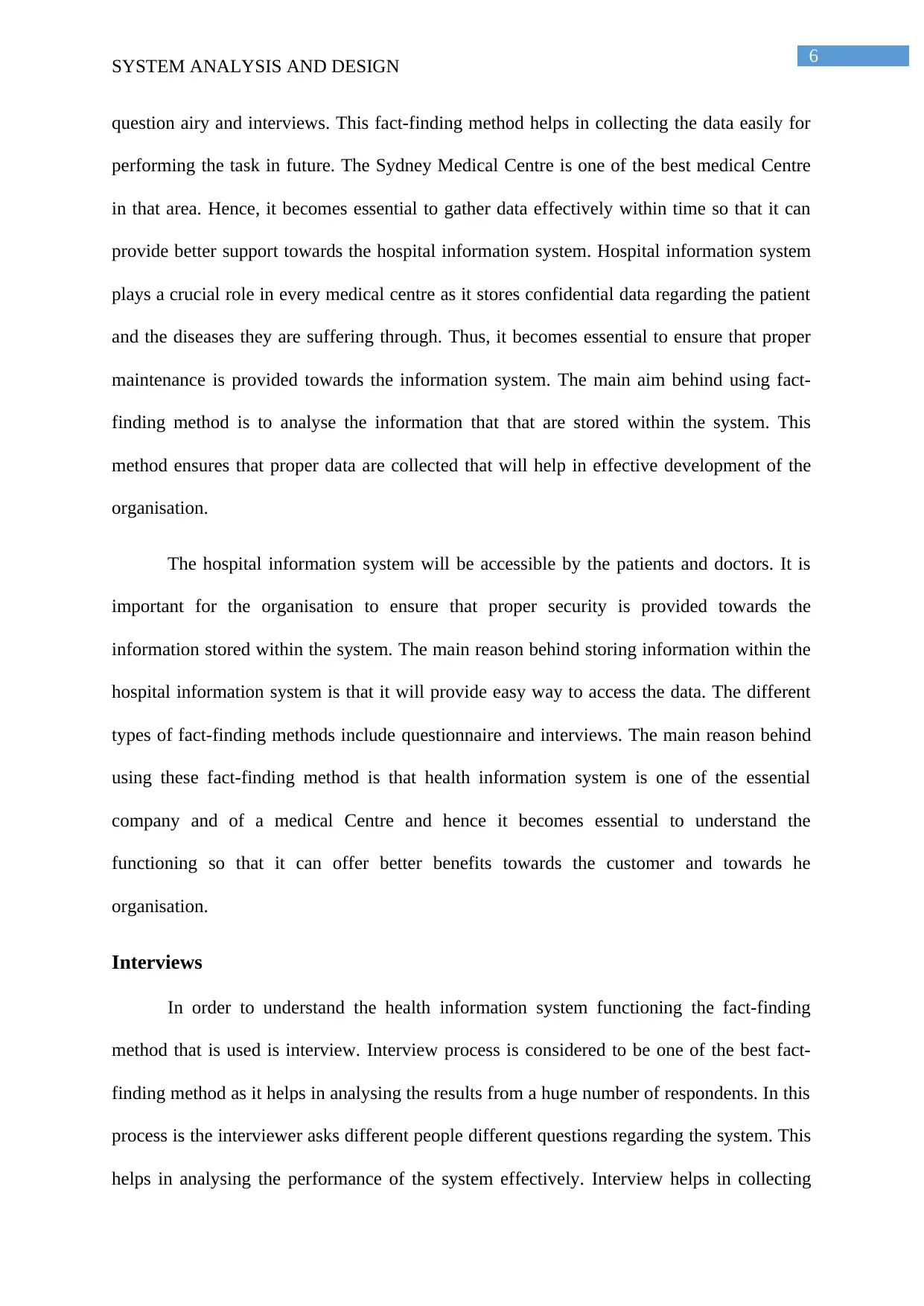
6
SYSTEM ANALYSIS AND DESIGN
question airy and interviews. This fact-finding method helps in collecting the data easily for
performing the task in future. The Sydney Medical Centre is one of the best medical Centre
in that area. Hence, it becomes essential to gather data effectively within time so that it can
provide better support towards the hospital information system. Hospital information system
plays a crucial role in every medical centre as it stores confidential data regarding the patient
and the diseases they are suffering through. Thus, it becomes essential to ensure that proper
maintenance is provided towards the information system. The main aim behind using fact-
finding method is to analyse the information that that are stored within the system. This
method ensures that proper data are collected that will help in effective development of the
organisation.
The hospital information system will be accessible by the patients and doctors. It is
important for the organisation to ensure that proper security is provided towards the
information stored within the system. The main reason behind storing information within the
hospital information system is that it will provide easy way to access the data. The different
types of fact-finding methods include questionnaire and interviews. The main reason behind
using these fact-finding method is that health information system is one of the essential
company and of a medical Centre and hence it becomes essential to understand the
functioning so that it can offer better benefits towards the customer and towards he
organisation.
Interviews
In order to understand the health information system functioning the fact-finding
method that is used is interview. Interview process is considered to be one of the best fact-
finding method as it helps in analysing the results from a huge number of respondents. In this
process is the interviewer asks different people different questions regarding the system. This
helps in analysing the performance of the system effectively. Interview helps in collecting
SYSTEM ANALYSIS AND DESIGN
question airy and interviews. This fact-finding method helps in collecting the data easily for
performing the task in future. The Sydney Medical Centre is one of the best medical Centre
in that area. Hence, it becomes essential to gather data effectively within time so that it can
provide better support towards the hospital information system. Hospital information system
plays a crucial role in every medical centre as it stores confidential data regarding the patient
and the diseases they are suffering through. Thus, it becomes essential to ensure that proper
maintenance is provided towards the information system. The main aim behind using fact-
finding method is to analyse the information that that are stored within the system. This
method ensures that proper data are collected that will help in effective development of the
organisation.
The hospital information system will be accessible by the patients and doctors. It is
important for the organisation to ensure that proper security is provided towards the
information stored within the system. The main reason behind storing information within the
hospital information system is that it will provide easy way to access the data. The different
types of fact-finding methods include questionnaire and interviews. The main reason behind
using these fact-finding method is that health information system is one of the essential
company and of a medical Centre and hence it becomes essential to understand the
functioning so that it can offer better benefits towards the customer and towards he
organisation.
Interviews
In order to understand the health information system functioning the fact-finding
method that is used is interview. Interview process is considered to be one of the best fact-
finding method as it helps in analysing the results from a huge number of respondents. In this
process is the interviewer asks different people different questions regarding the system. This
helps in analysing the performance of the system effectively. Interview helps in collecting
Paraphrase This Document
Need a fresh take? Get an instant paraphrase of this document with our AI Paraphraser
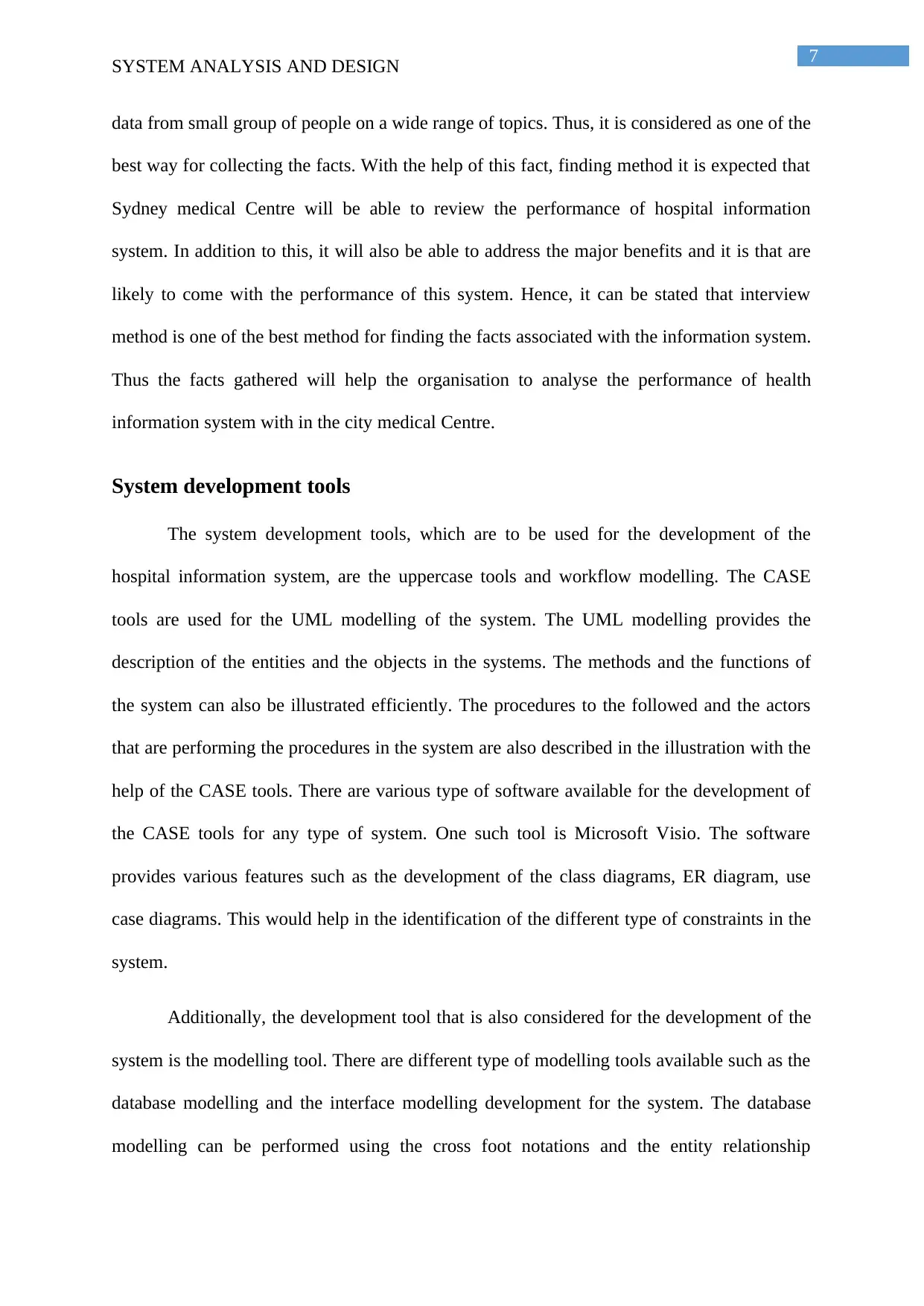
7
SYSTEM ANALYSIS AND DESIGN
data from small group of people on a wide range of topics. Thus, it is considered as one of the
best way for collecting the facts. With the help of this fact, finding method it is expected that
Sydney medical Centre will be able to review the performance of hospital information
system. In addition to this, it will also be able to address the major benefits and it is that are
likely to come with the performance of this system. Hence, it can be stated that interview
method is one of the best method for finding the facts associated with the information system.
Thus the facts gathered will help the organisation to analyse the performance of health
information system with in the city medical Centre.
System development tools
The system development tools, which are to be used for the development of the
hospital information system, are the uppercase tools and workflow modelling. The CASE
tools are used for the UML modelling of the system. The UML modelling provides the
description of the entities and the objects in the systems. The methods and the functions of
the system can also be illustrated efficiently. The procedures to the followed and the actors
that are performing the procedures in the system are also described in the illustration with the
help of the CASE tools. There are various type of software available for the development of
the CASE tools for any type of system. One such tool is Microsoft Visio. The software
provides various features such as the development of the class diagrams, ER diagram, use
case diagrams. This would help in the identification of the different type of constraints in the
system.
Additionally, the development tool that is also considered for the development of the
system is the modelling tool. There are different type of modelling tools available such as the
database modelling and the interface modelling development for the system. The database
modelling can be performed using the cross foot notations and the entity relationship
SYSTEM ANALYSIS AND DESIGN
data from small group of people on a wide range of topics. Thus, it is considered as one of the
best way for collecting the facts. With the help of this fact, finding method it is expected that
Sydney medical Centre will be able to review the performance of hospital information
system. In addition to this, it will also be able to address the major benefits and it is that are
likely to come with the performance of this system. Hence, it can be stated that interview
method is one of the best method for finding the facts associated with the information system.
Thus the facts gathered will help the organisation to analyse the performance of health
information system with in the city medical Centre.
System development tools
The system development tools, which are to be used for the development of the
hospital information system, are the uppercase tools and workflow modelling. The CASE
tools are used for the UML modelling of the system. The UML modelling provides the
description of the entities and the objects in the systems. The methods and the functions of
the system can also be illustrated efficiently. The procedures to the followed and the actors
that are performing the procedures in the system are also described in the illustration with the
help of the CASE tools. There are various type of software available for the development of
the CASE tools for any type of system. One such tool is Microsoft Visio. The software
provides various features such as the development of the class diagrams, ER diagram, use
case diagrams. This would help in the identification of the different type of constraints in the
system.
Additionally, the development tool that is also considered for the development of the
system is the modelling tool. There are different type of modelling tools available such as the
database modelling and the interface modelling development for the system. The database
modelling can be performed using the cross foot notations and the entity relationship
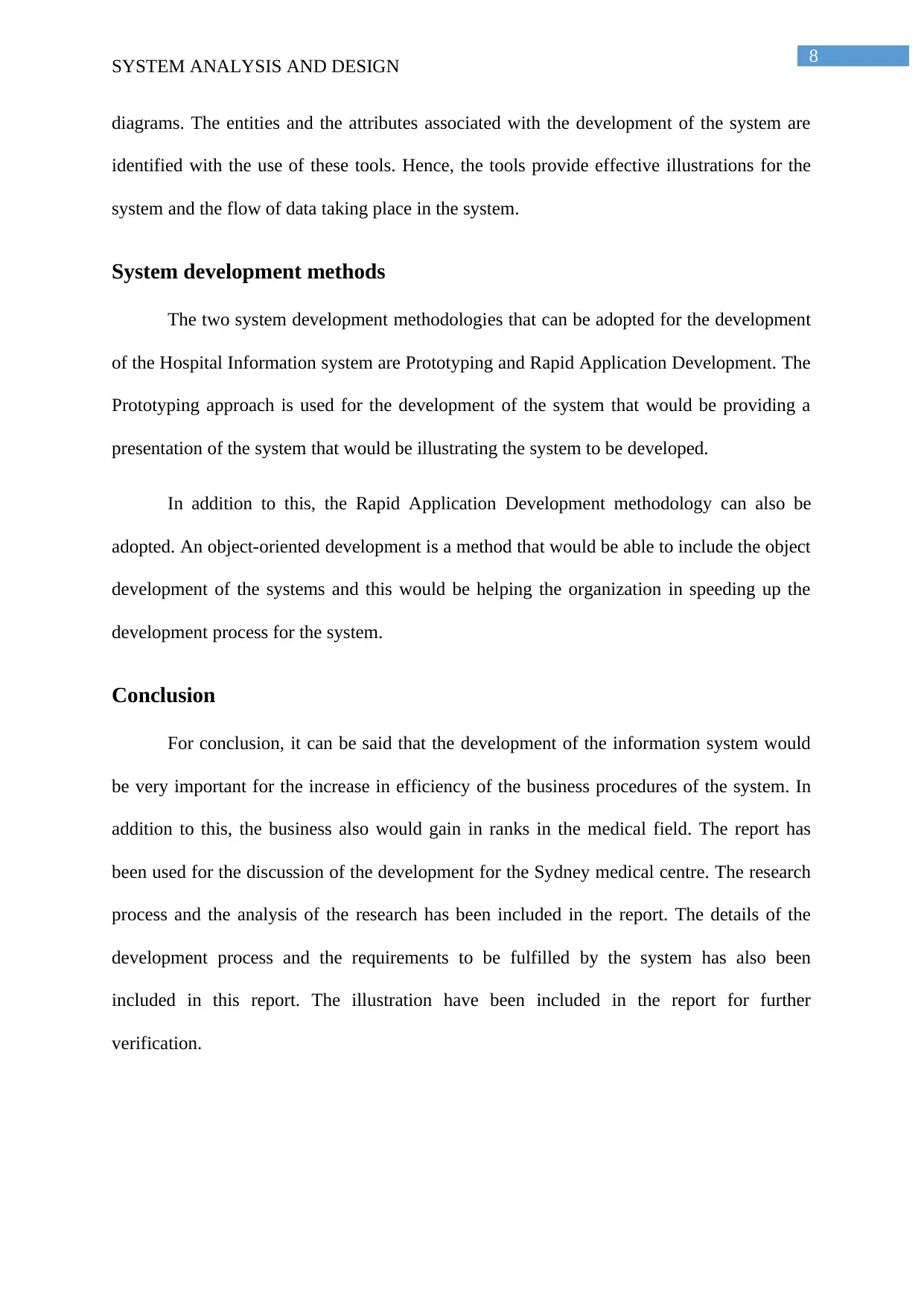
8
SYSTEM ANALYSIS AND DESIGN
diagrams. The entities and the attributes associated with the development of the system are
identified with the use of these tools. Hence, the tools provide effective illustrations for the
system and the flow of data taking place in the system.
System development methods
The two system development methodologies that can be adopted for the development
of the Hospital Information system are Prototyping and Rapid Application Development. The
Prototyping approach is used for the development of the system that would be providing a
presentation of the system that would be illustrating the system to be developed.
In addition to this, the Rapid Application Development methodology can also be
adopted. An object-oriented development is a method that would be able to include the object
development of the systems and this would be helping the organization in speeding up the
development process for the system.
Conclusion
For conclusion, it can be said that the development of the information system would
be very important for the increase in efficiency of the business procedures of the system. In
addition to this, the business also would gain in ranks in the medical field. The report has
been used for the discussion of the development for the Sydney medical centre. The research
process and the analysis of the research has been included in the report. The details of the
development process and the requirements to be fulfilled by the system has also been
included in this report. The illustration have been included in the report for further
verification.
SYSTEM ANALYSIS AND DESIGN
diagrams. The entities and the attributes associated with the development of the system are
identified with the use of these tools. Hence, the tools provide effective illustrations for the
system and the flow of data taking place in the system.
System development methods
The two system development methodologies that can be adopted for the development
of the Hospital Information system are Prototyping and Rapid Application Development. The
Prototyping approach is used for the development of the system that would be providing a
presentation of the system that would be illustrating the system to be developed.
In addition to this, the Rapid Application Development methodology can also be
adopted. An object-oriented development is a method that would be able to include the object
development of the systems and this would be helping the organization in speeding up the
development process for the system.
Conclusion
For conclusion, it can be said that the development of the information system would
be very important for the increase in efficiency of the business procedures of the system. In
addition to this, the business also would gain in ranks in the medical field. The report has
been used for the discussion of the development for the Sydney medical centre. The research
process and the analysis of the research has been included in the report. The details of the
development process and the requirements to be fulfilled by the system has also been
included in this report. The illustration have been included in the report for further
verification.
⊘ This is a preview!⊘
Do you want full access?
Subscribe today to unlock all pages.

Trusted by 1+ million students worldwide
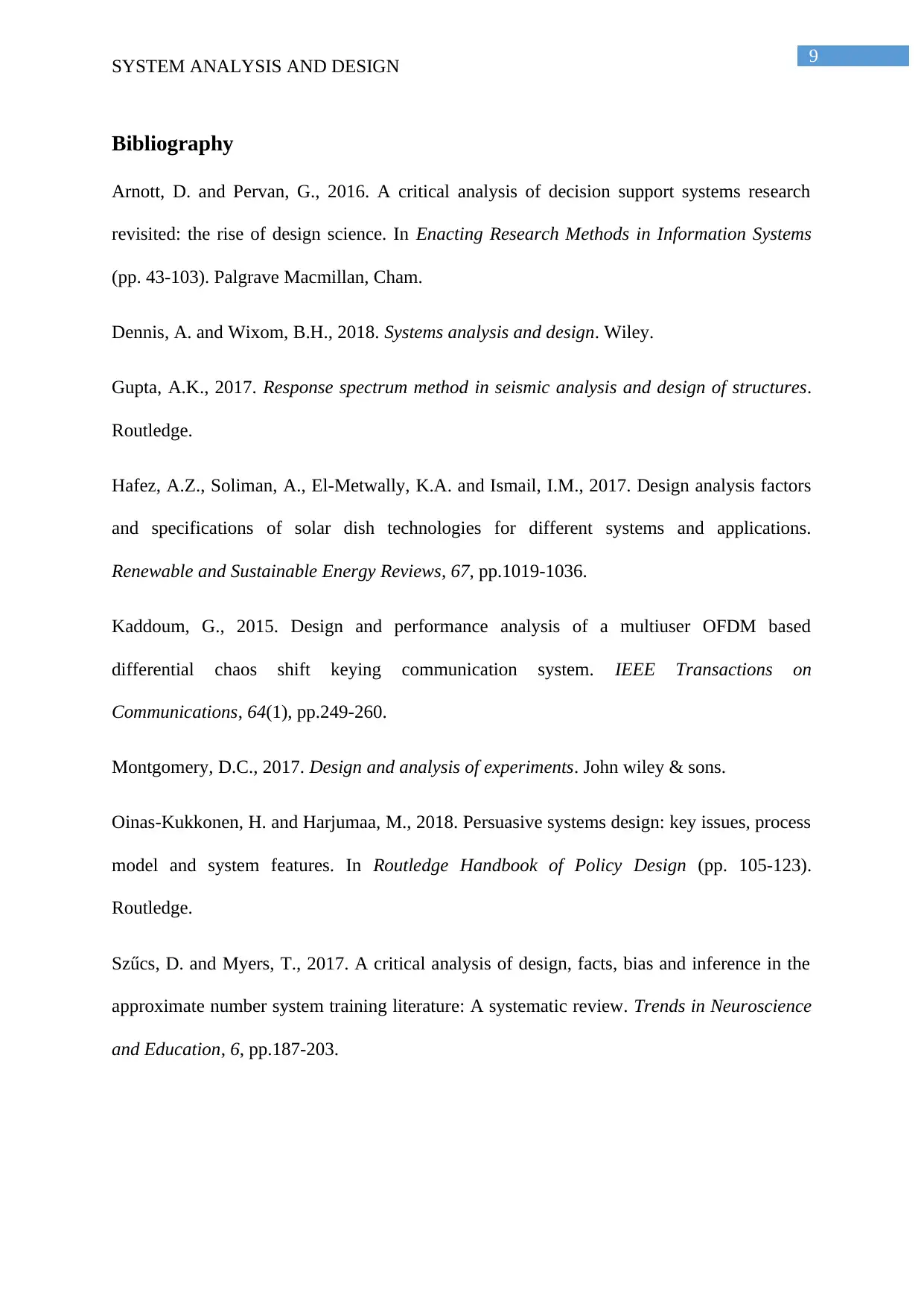
9
SYSTEM ANALYSIS AND DESIGN
Bibliography
Arnott, D. and Pervan, G., 2016. A critical analysis of decision support systems research
revisited: the rise of design science. In Enacting Research Methods in Information Systems
(pp. 43-103). Palgrave Macmillan, Cham.
Dennis, A. and Wixom, B.H., 2018. Systems analysis and design. Wiley.
Gupta, A.K., 2017. Response spectrum method in seismic analysis and design of structures.
Routledge.
Hafez, A.Z., Soliman, A., El-Metwally, K.A. and Ismail, I.M., 2017. Design analysis factors
and specifications of solar dish technologies for different systems and applications.
Renewable and Sustainable Energy Reviews, 67, pp.1019-1036.
Kaddoum, G., 2015. Design and performance analysis of a multiuser OFDM based
differential chaos shift keying communication system. IEEE Transactions on
Communications, 64(1), pp.249-260.
Montgomery, D.C., 2017. Design and analysis of experiments. John wiley & sons.
Oinas-Kukkonen, H. and Harjumaa, M., 2018. Persuasive systems design: key issues, process
model and system features. In Routledge Handbook of Policy Design (pp. 105-123).
Routledge.
Szűcs, D. and Myers, T., 2017. A critical analysis of design, facts, bias and inference in the
approximate number system training literature: A systematic review. Trends in Neuroscience
and Education, 6, pp.187-203.
SYSTEM ANALYSIS AND DESIGN
Bibliography
Arnott, D. and Pervan, G., 2016. A critical analysis of decision support systems research
revisited: the rise of design science. In Enacting Research Methods in Information Systems
(pp. 43-103). Palgrave Macmillan, Cham.
Dennis, A. and Wixom, B.H., 2018. Systems analysis and design. Wiley.
Gupta, A.K., 2017. Response spectrum method in seismic analysis and design of structures.
Routledge.
Hafez, A.Z., Soliman, A., El-Metwally, K.A. and Ismail, I.M., 2017. Design analysis factors
and specifications of solar dish technologies for different systems and applications.
Renewable and Sustainable Energy Reviews, 67, pp.1019-1036.
Kaddoum, G., 2015. Design and performance analysis of a multiuser OFDM based
differential chaos shift keying communication system. IEEE Transactions on
Communications, 64(1), pp.249-260.
Montgomery, D.C., 2017. Design and analysis of experiments. John wiley & sons.
Oinas-Kukkonen, H. and Harjumaa, M., 2018. Persuasive systems design: key issues, process
model and system features. In Routledge Handbook of Policy Design (pp. 105-123).
Routledge.
Szűcs, D. and Myers, T., 2017. A critical analysis of design, facts, bias and inference in the
approximate number system training literature: A systematic review. Trends in Neuroscience
and Education, 6, pp.187-203.
Paraphrase This Document
Need a fresh take? Get an instant paraphrase of this document with our AI Paraphraser
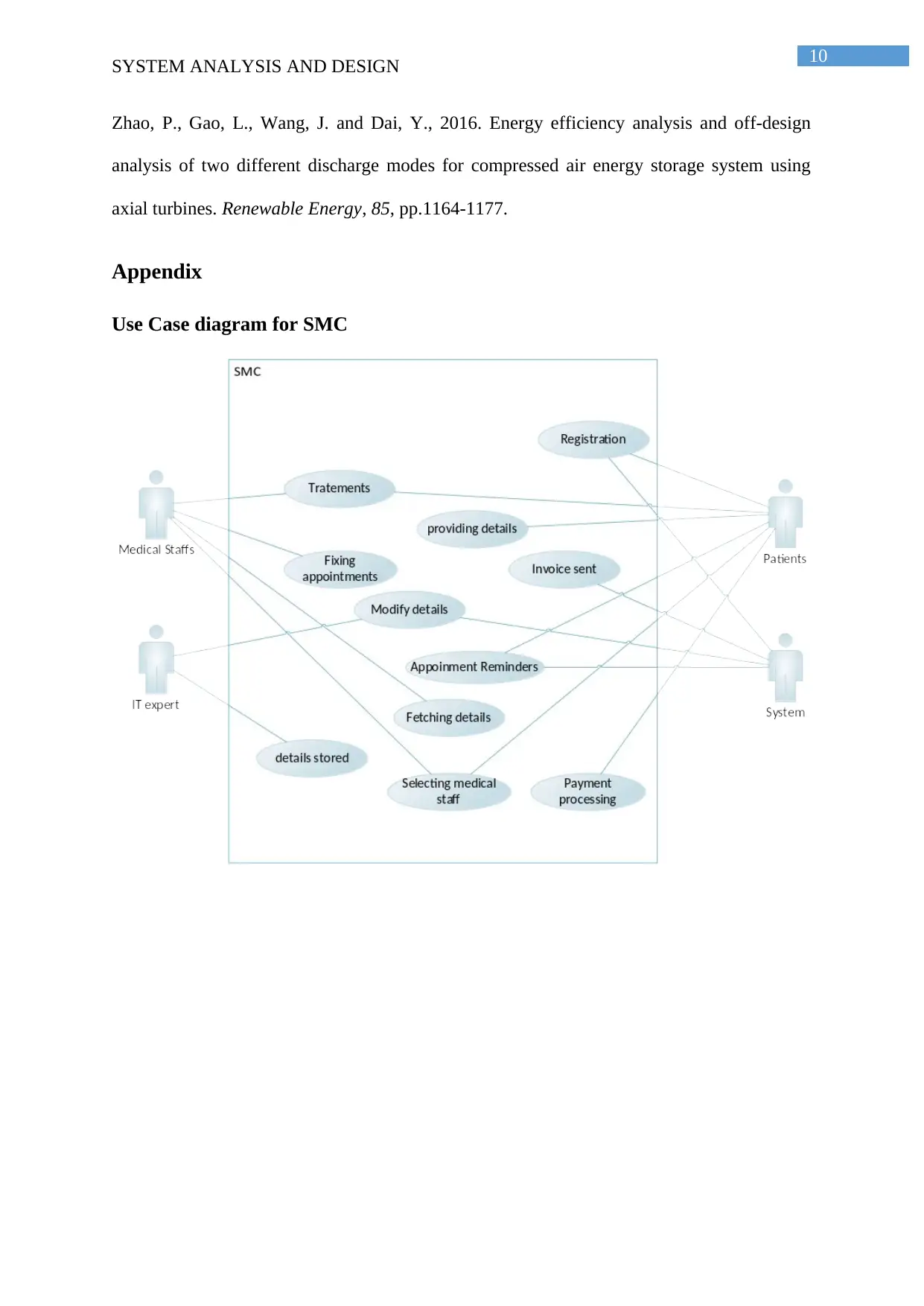
10
SYSTEM ANALYSIS AND DESIGN
Zhao, P., Gao, L., Wang, J. and Dai, Y., 2016. Energy efficiency analysis and off-design
analysis of two different discharge modes for compressed air energy storage system using
axial turbines. Renewable Energy, 85, pp.1164-1177.
Appendix
Use Case diagram for SMC
SYSTEM ANALYSIS AND DESIGN
Zhao, P., Gao, L., Wang, J. and Dai, Y., 2016. Energy efficiency analysis and off-design
analysis of two different discharge modes for compressed air energy storage system using
axial turbines. Renewable Energy, 85, pp.1164-1177.
Appendix
Use Case diagram for SMC
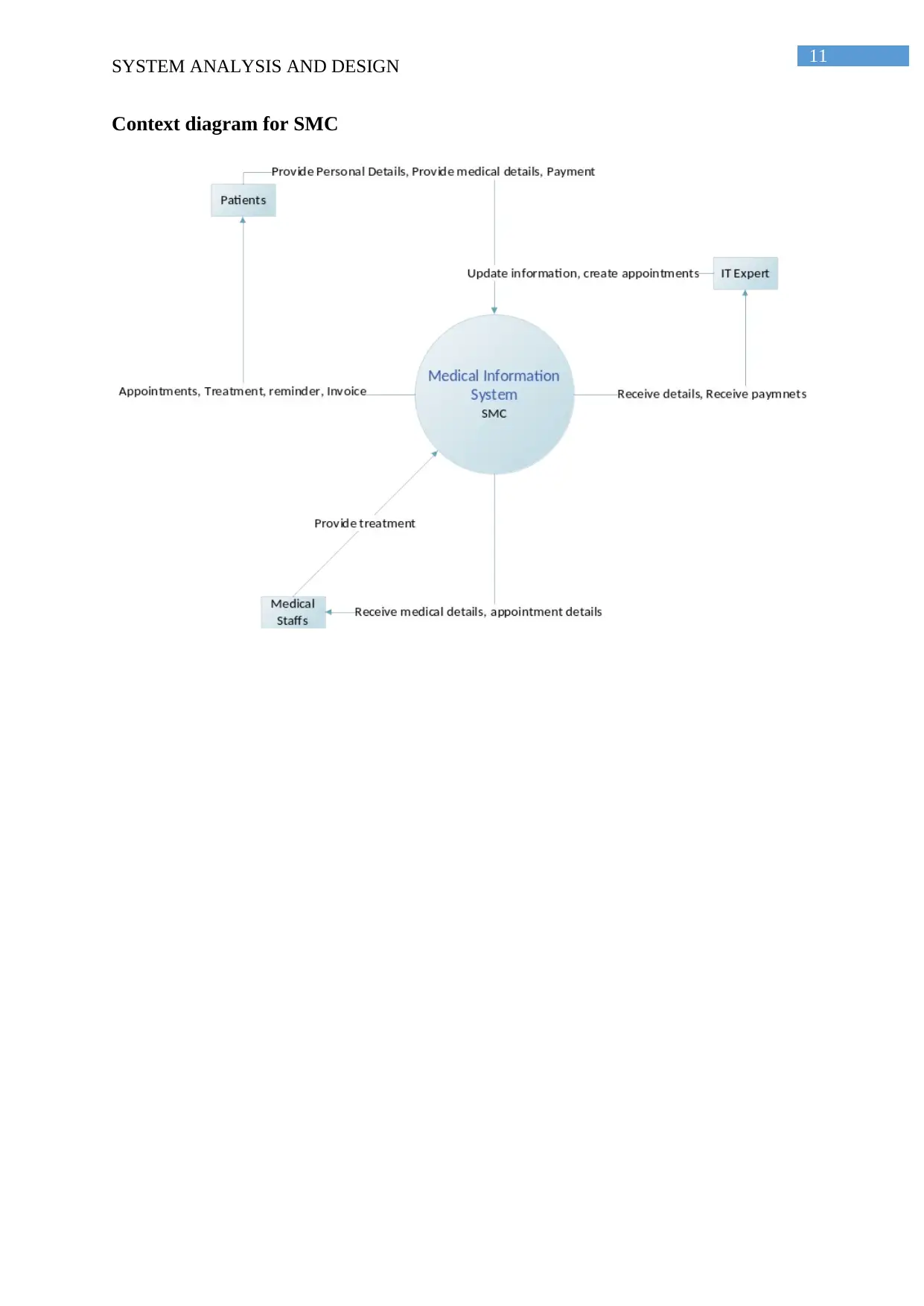
11
SYSTEM ANALYSIS AND DESIGN
Context diagram for SMC
SYSTEM ANALYSIS AND DESIGN
Context diagram for SMC
⊘ This is a preview!⊘
Do you want full access?
Subscribe today to unlock all pages.

Trusted by 1+ million students worldwide
1 out of 15
Related Documents
Your All-in-One AI-Powered Toolkit for Academic Success.
+13062052269
info@desklib.com
Available 24*7 on WhatsApp / Email
![[object Object]](/_next/static/media/star-bottom.7253800d.svg)
Unlock your academic potential
Copyright © 2020–2025 A2Z Services. All Rights Reserved. Developed and managed by ZUCOL.




